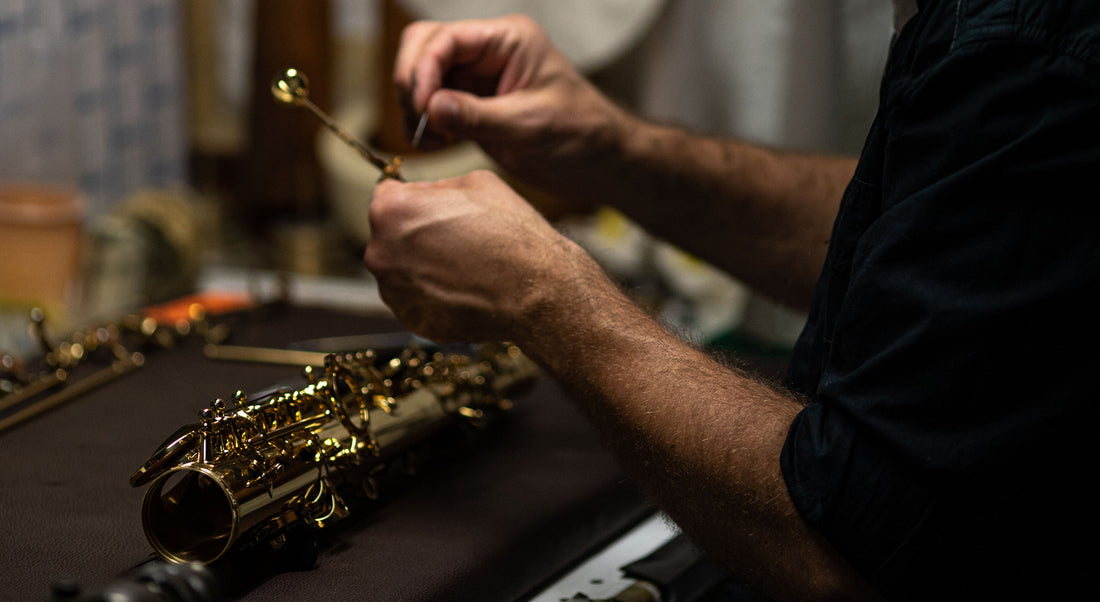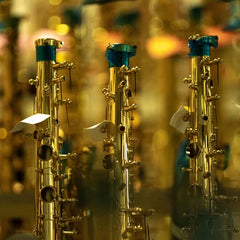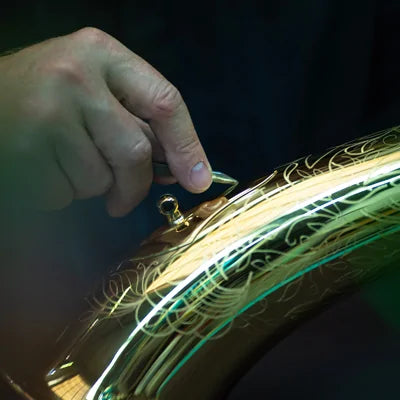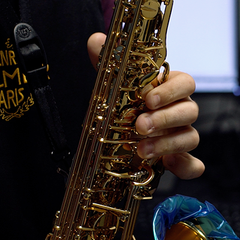Birth of a saxophone at the Henri SELMER Paris factory

Metalworking
Metalworking gathers together all of the operations which make it possible to manufacture the acoustic tube of the instrument: brass-shaping, drawing-out, welding, tempering, inflating, buffing.

The body is manufactured from a brass sheet of 0.6-0.7 millimetre thickness, cut in the shape of trapezoid. The sheet is rolled, welded and drawn out on a conical chuck. The body is then bored with oblong holes from which the tone holes are drawn-out, a technology initiated and used by Selmer Paris since 1922. Throughout the production cycle, the brass-shaping work requires the assistance of several tempering processes. This technique makes it possible to eliminate the constraints created in the metal and to regain a state favorable to new deformation.
The bow is pressed into two half-shells, then assembled by brazing. It is set at its final size by hydraulic inflation: a liquid is injected under high pressure into the part inserted in a matrix, giving the piece its final dimensions. The tone holes are then drawn out according to the same process as the body.
For the bell, there are two types of manufacture:
- The left and right halves of the bell are pressed in the same manner as for the bow, then argon welded, a process which preserves the homogeneity of the metal, and therefore of its acoustics. This technique is used for the bells of the alto and tenor saxophones.
- For the larger sizes like the baritone, the bell is hand-shaped using only one piece, then welded.

Once the bells are preformed, they are adjusted and stretched on chucks in order to give them their final dimensions. A brass wire is placed on the higher edge of the bell to reinforce its opening and enable it to vibrate. The material used for the ring can also have an acoustic effect. At the end of the metalworking cycle, the parts undergo a prepolishing buffing treatment which prepares the surface.
The neck, manufactured like the body, is then curved through ice and inflated hydraulically.
The mechanical operations

The primary parts making up the keywork (key arms, pad cups, side keys…) and other elements added onto the saxophone (posts, bell to body ring, strap ring, bow reinforcement) are machined. Depending on their configuration, these components in turn will be cut, drilled, beveled, stamped, milled etc… The posts, screws and bolts are turned on digitally controlled CNC machines. The plates are cut out and shaped on a press. All these parts are rigorously controlled for flaws and stocked in a “Spare Parts” store.
 The manufacture of the sub-assemblies
The manufacture of the sub-assemblies
The posts are positioned on the plates by electrical plotting, then soldered with silver for final fastening.
The various primary parts are silver soldered onto the skeleton positions ; after quality control they are stored in the “Sub-assemblies” store.
Assembling the body
 The body’s assembly consists of fastening the plate assemblies which support the keywork and the accessories (escutcheon, key guide, thumb rest plate, tenon…) to the parts made in the metalworking department (neck, body, bow and bell). These elements are pre-positioned on the body thanks to adapted assemblies. Plotted electrically, they are then soldered. In order to get rid of any potential residues, the unit is passed through a desoldering bath, supplemented by manual filing.
The body’s assembly consists of fastening the plate assemblies which support the keywork and the accessories (escutcheon, key guide, thumb rest plate, tenon…) to the parts made in the metalworking department (neck, body, bow and bell). These elements are pre-positioned on the body thanks to adapted assemblies. Plotted electrically, they are then soldered. In order to get rid of any potential residues, the unit is passed through a desoldering bath, supplemented by manual filing.
Engraving

Since the advent of its very first models, Selmer Paris has always paid detailed attention to the elegance of its engravings. In the beginning, the execution varied according to the inspiration of the individual instrument maker. Today, it is a unique expertise of a specialised division of the Selmer workshops. This very delicate art requires skill and experience, especially as this stage comes at the end of the manufacturing process. The movements must be measured and sure at the same time taking into account the thinness of the material in the flared part of the bell. After having drawn the motif on the bell with a soft lead pencil, the engraver chisels the contours with a very fine engraving tool (0.5 mm broad). He then uses four or five wider tools to create shade and relief. An entire artform preserved intact across the passage of time…
The finishing

All of the keys are placed and adjusted along the neck, the body and the bell of the instrument.
The body and the bell/bow unit are finally assembled using the removable ring (body/bow) and the bell to body ring (body/bell). The keywork is finally attached to the instrument, and each key is individually adjusted and checked for leakage.
This is done using a light shone inside the bore to pick up the existence of any leak between the pad and the tone hole. Lastly, the neck is paired with the instrument.
Certification
 Each instrument is tested at the end of the production cycle and a series of specific checks verify the quality of the instrument’s acoustic and mechanical performance. These tests are carried out in soundproofed booths by specialized technicians.
Each instrument is tested at the end of the production cycle and a series of specific checks verify the quality of the instrument’s acoustic and mechanical performance. These tests are carried out in soundproofed booths by specialized technicians.
This handicraft know-how, traditional and unique, coupled with the capacity of innovation and the use of cutting-edge technologies (and several millions USD invested in R&D every year) are the backbone of the world-class reputation of Selmer instruments.
► More information on our workshops
Photo credit: © Henri SELMER Paris / Loïc Guilpain